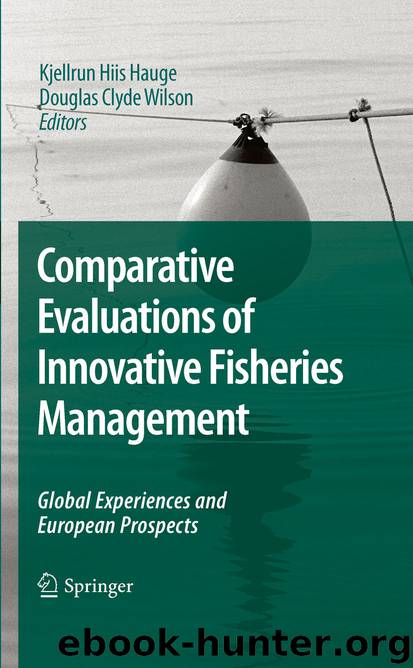Comparative Evaluations of Innovative Fisheries Management by Kjellrun Hiis Hauge & Douglas Clyde Wilson

Author:Kjellrun Hiis Hauge & Douglas Clyde Wilson
Language: eng
Format: epub
Publisher: Springer Netherlands, Dordrecht
6.2.4 Western Shelf Anchovy(Engraulis Encrasicolus): Evaluating Decision Rules
For the Western Shelf anchovy case the hypothesis H3 (Table 6.1) was tested, centred upon decision rules. The goal of testing this hypothesis was to explore the possible effects of harvest control rules (HCR) on biological robustness (BR).
6.2.4.1 Background
The Western Shelf anchovy fisheries have been closed since the second half of 2005, except for 1750 tons captured during a reopening in the first half of 2006 and 136 tons captured by the French fleet in 2007 in the framework of an experimental-commercial fishery with observers onboard. The closure was a reaction to the poor condition of the spawning stock, assessed to be below Blim (21,000 t) in 2005 and to remain below Bpa (33,000 t) from 2006 to 2008. Until the closure, the anchovy fishery was managed by a fixed annual total allowable catch (TAC) that was split into country quotas, with associated technical measures, such as minimum landing size and minimum mesh size in some areas and for some gears (Council Regulation No 850/98). Historically, the TAC has been set around 30.000–33.000 tons without taking variations in recruitment into account.
Currently two research surveys are conducted in the spring each year to assess the anchovy stock: an ichthyoplankton and adult survey for the implementation of the daily egg production method and an acoustic survey. Since 2003 a juvenile acoustic survey is conducted in the autumn each year (ICES, 2008a). Currently this survey is under development and being tested, but will hopefully provide yearly estimates of next year’s recruitment that would assist management advice.
Both scientific working groups and the fishing industry agree that the current management of this stock is not adequate and needs to be reviewed. Decision rules are looked upon as a potential innovative option for the anchovy fisheries, as an adaptive management tool suggested by the ICES working group on the assessment of mackerel, horse mackerel, sardine and anchovy (ICES, 2004). In addition, the STECF states in 2008 that ‘complementary management measures to output control (TAC) need to be further investigated to maintain the longer-term viability of the stock (closed seasons, closed areas, minimum size, etc.).’ (STECF, 2008).
Currently the European Commission intends to propose a long-term management plan for the anchovy, to be implemented as soon as the stock has recovered. To provide the necessary scientific basis, the biological and economical performance of two basic harvest control rules (HCRs) has been evaluated (STECF, 2008). In these management strategy evaluations, the traditional January to December management calendar has been replaced by a management cycle from July to June, in which the HCRs catch options are based solely on the results of the just completed spring survey. With this approach the major uncertainty arises from the recruitment level and the fisheries during the first half of the year, which are unknown at the time of setting the TAC. Therefore the HCR has to be robust, not only regarding the observation errors of the spring surveys, but also regarding the uncertainty about the next recruitment.
Download
This site does not store any files on its server. We only index and link to content provided by other sites. Please contact the content providers to delete copyright contents if any and email us, we'll remove relevant links or contents immediately.
International Integration of the Brazilian Economy by Elias C. Grivoyannis(90670)
The Radium Girls by Kate Moore(11921)
Turbulence by E. J. Noyes(7935)
Nudge - Improving Decisions about Health, Wealth, and Happiness by Thaler Sunstein(7613)
The Black Swan by Nassim Nicholas Taleb(7010)
Rich Dad Poor Dad by Robert T. Kiyosaki(6398)
Pioneering Portfolio Management by David F. Swensen(6226)
Man-made Catastrophes and Risk Information Concealment by Dmitry Chernov & Didier Sornette(5921)
Zero to One by Peter Thiel(5684)
Secrecy World by Jake Bernstein(4640)
Millionaire: The Philanderer, Gambler, and Duelist Who Invented Modern Finance by Janet Gleeson(4374)
The Age of Surveillance Capitalism by Shoshana Zuboff(4209)
Skin in the Game by Nassim Nicholas Taleb(4161)
Bullshit Jobs by David Graeber(4094)
The Money Culture by Michael Lewis(4073)
Skin in the Game: Hidden Asymmetries in Daily Life by Nassim Nicholas Taleb(3929)
The Dhandho Investor by Mohnish Pabrai(3698)
The Wisdom of Finance by Mihir Desai(3649)
Blockchain Basics by Daniel Drescher(3495)
